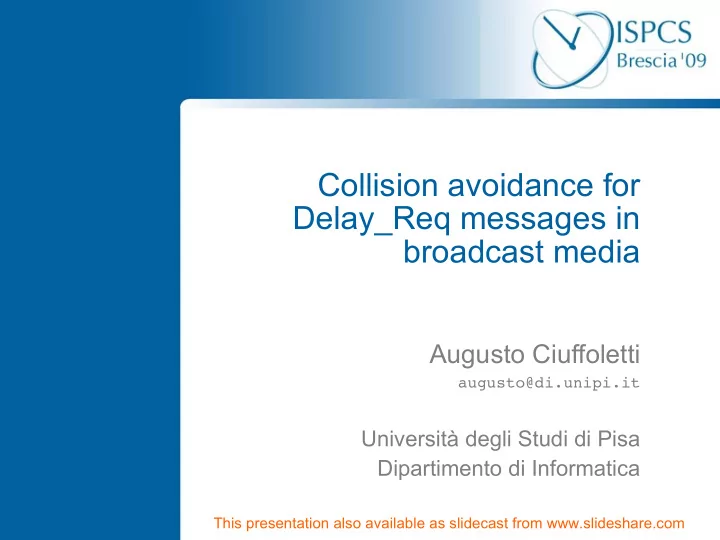

Collision avoidance for Delay_Req messages in broadcast media Augusto Ciuffoletti augusto@di.unipi.it Università degli Studi di Pisa Dipartimento di Informatica This presentation also available as slidecast from www.slideshare.com
Outline of the presentation • Motivation and problem description • The algorithm • Implementation issues • Validation by analytical model and simulation 2 11/04/09
System model • The system is composed by a (large) number of slave clocks • There is one master clock in charge of maintaining clock synchronized • Network is a broadcast medium with unique collision domain • Slaves require to be adjusted with Delay_Req/ Delay_Resp with bounded periodicity Idea: Exploit broadcast to avoid collision 3 11/04/09
Collision events • Two Delay_Req Master Slaves msgs sent at approx the same time • The (broadcast) Delay_Req network transports them in different collision times • They are serviced Asymmetry with some delay • Asymmetry and jitter are introduced 4 11/04/09
How frequently this event occurs? • R: It depends on the distribution of Delay_Req events • We assume that all slaves want to refresh their clock with the same frequency. • IEEE1588 avoids clustering of Delay_Req messages using random delays (clause 9.5.11.2) • This has the effect of keeping the density of Delay_Req events constant in time 5 11/04/09
Probability of collision • We introduce two system constants: n : the number of slaves δ : the period between successive Delay_Req on one slave • Expected number of Delay_Req per time unit λ=n/δ • To evaluate the probability of collision, we need to introduce the duration of the event τ 1-(1+r)e -r with r=λτ 6 11/04/09
Probability of collision p=5 10 -5 τ=10 μsec N=1000 δ=1 sec 1 collision 7 every 2000 secs 11/04/09
Requirements for a collision avoidance algorithm • Bounded timing of Delay_Req (from slave perspective); • Lower probability of collision events with respect to random scheduling • Low traffic overhead • Embedded into existing protocol 8 11/04/09
The basic idea: token scheduling • A token is circulated: the slave holding the token sends the Delay_Req however • Additional control to implement the overlay ring • Additional bandwidth to implement token exchange • Uncertain roundtrip time • Compensated by (apparent) deterministic collision avoidance 9 11/04/09
Introducing random walks • Randomized control of the overlay network (token destination selected at random in a random set of neighbors) • Token carried by the same Delay_Req/Delay_Resp pair • Global view to enforce bounded return time 10 11/04/09
Token circulation algorithm slave part • Maintain a dynamic, random list of neighbors observing the traffic on the broadcast medium • Wait to receive a token • Send the Delay_Req upon receiving a token • Deliver the token to a neighbor at random OK, but what about bounded return time? 11 11/04/09
Token circulation algorithm master part • The master maintains the timeouts of all slaves • When one of the slaves is about to exceed the return time bound the master reroutes the token to feed the starving slave • The data structure needed for the task is not discussed in the paper How does an IP device de-route a token... ...and what is a token, after all? 12 11/04/09
What is a token, anyway? • There is no token in fact: it is just an abstraction • “Holding the token” is a flag in the state of the slave • The slave holding the token indicates, in the Delay_Req packet, the MAC of the next holder • The master may reroute the token by indicating a different token holder in the Delay_Resp • Remember that we are in a broadcast network: everybody sees every packet 13 11/04/09
Implementation issues • Not enough room in a Delay_Req Delay_Req (5 octets + 4 bits available) frame to hold a MAC address (6 octets) • Unless MAC are locally administered • Our solution: – Use 3 octets in both Delay_Req and Delay_Resp – In case of ambiguity, the master disambiguates completing the MAC – In case of rerouting and ambiguity, two “Delay_Resp” are required (extra network load) 14 11/04/09
Evaluating the solution • Residual collision event: two timeout are generated at the same time • The master selects one of them to receive the token • The figure compares native random scheduling with token scheduling • The model considers a full mesh overlay • Colliding events are discarded 15 11/04/09
Evaluating the solution • To evaluate the impact of the two approximations, we used simulation. r=0.2 • The right spike is motivated by the slaves that receive the token as a consequence of a timeout • The deviation is due to bounded degree approximation of the network 16 11/04/09
Conclusions • In a broadcast network with many slaves Delay_Req messages may collide, and deteriorate synchronization • We use the power of broadcast (the reason of the problem) to reduce the risk of collision • Timing of Delay_Req is bounded (as required) • No network overhead (as required) • No change in message format (as required) 17 11/04/09
Recommend
More recommend